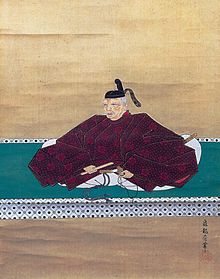Honda Masanobu
Honda Masanobu | |
|---|---|
| 本多 正信 | |
 | |
| Daimyō of Tamanawa | |
| In office 1590–1616 | |
| Succeeded by | Matsudaira Masatsuna |
| Personal details | |
| Born | 1538 Mikawa Province, Japan |
| Died | July 20, 1616 Edo, Japan |
| Resting place | Nishi Hongan-ji, Kyoto, Japan |
| Military service | |
| Allegiance |  Tokugawa clan Tokugawa clan Tokugawa shogunate Tokugawa shogunate |
| Battles/wars | Battle of Azukizaka (1564) Battle of Komaki-Nagakute (1584) Siege of Ueda (1600) Siege of Osaka (1614) |
Honda Masanobu (本多 正信, 1538 – July 20, 1616) was a commander and daimyō in the service of Tokugawa Ieyasu in Japan during the Azuchi-Momoyama and Edo periods.[1]
In 1563, when an uprising against Ieyasu occurred in Mikawa Province, Masanobu took the side of the peasants against Ieyasu at Battle of Batogahara. He fled from the Tokugawa, rejoining them in the 1570s or 1580s at the behest of Ōkubo Tadayo, and accompanied Ieyasu as he crossed Iga Province following the assassination of Oda Nobunaga at Honnō-ji.
In 1600, Masanobu joined Tokugawa Hidetada's army for the march along the Nakasendō. En route, however, Hidetada attacked Sanada Masayuki at Ueda Castle against Masanobu's advice, and together they arrived late for the Battle of Sekigahara.
Masanobu was a member of the Tokugawa shogunate and ruled a Han in Sagami Province assessed at 22,000 koku. He was present at the siege of Osaka in 1614. Masanobu died several weeks after Ieyasu in 1616.
It is said that other Tokugawa retainers disliked Masanobu, such as Sakakibara Yasumasa who regarded him as "corrupt", and Honda Tadakatsu though Masanobu a coward.[2]
| Preceded by none | Daimyō of Tamanawa 1590–1616 | Succeeded by Matsudaira Masatsuna |
References
- ^ John Whitney Hall (1999). The Cambridge History of Japan. Cambridge University Press. p. 494. ISBN 0-521-22354-7.
- ^ Conrad Totman (1967). Politics in the Tokugawa Bakufu, 1600-1843. Harvard University Press. p. 247. Retrieved 7 May 2024.
Further reading

- v
- t
- e
- Amago Tsunehisa
- Amago Haruhisa
- Asakura Yoshikage
- Ashina Moriuji
- Akechi Mitsuhide
- Azai Nagamasa
- Chōsokabe Motochika
- Date Terumune
- Date Masamune
- Hatakeyama Yoshitaka
- Honda Tadakatsu
- Hōjō Sōun
- Hōjō Ujimasa
- Hōjō Ujiyasu
- Ii Naomasa
- Imagawa Yoshimoto
- Imagawa Ujizane
- Isshiki Yoshimichi
- Itō Yoshisuke
- Kitabatake Tomonori
- Kuroda Nagamasa
- Matsunaga Hisahide
- Miyoshi Nagayoshi
- Mogami Yoshiaki
- Mōri Motonari
- Ōuchi Yoshitaka
- Ōuchi Yoshinaga
- Ōtomo Sōrin
- Rokkaku Yoshikata
- Ryūzōji Takanobu
- Saitō Dōsan
- Saitō Yoshitatsu
- Sakai Tadatsugu
- Sakakibara Yasumasa
- Satomi Yoshitaka
- Sanada Yukitaka
- Sanada Masayuki
- Sanada Nobuyuki
- Satake Yoshishige
- Sagara Yoshihi
- Shimazu Yoshihisa
- Shimazu Yoshihiro
- Tachibana Dōsetsu
- Takeda Nobutora
- Takeda Shingen
- Tōdō Takatora
- Uesugi Kagekatsu
- Uesugi Kenshin
- Uesugi Norimasa
- Ukita Naoie
- Uragami Munekage
- Yamana Toyokuni
- Yamana Suketoyo
- Kobayakawa Takakage
- Kuroda Yoshitaka
- Naoe Kanetsugu
- Takenaka Shigeharu
- Usami Sadamitsu
- Yamamoto Kansuke
mercenaries
religious figures
- Lady Acha
- Akohime
- Asahihime
- Lady Chaa
- Chikurin-in
- Gōhime
- Lady Goryū
- Dota Gozen
- Gotokuhime
- Tsumaki Hiroko
- Lady Hayakawa
- Hosokawa Gracia
- Irohahime
- Izumo no Okuni
- Shimazu Kameju
- Lady Kasuga
- Keigin-ni
- Kitsuno
- Konoe Sakiko
- Kōzōsu
- Kyōgoku Maria
- Kyōgoku Tatsuko
- Kyōun'in
- Matsuhime
- Megohime
- Lady Myōkyū
- Naitō Julia
- Nōhime
- Odai no Kata
- Oeyo
- Oichi
- Oinu
- Ohatsu
- Lady Ōkurakyo
- Ōmandokoro
- Ono Otsū
- Ōtomo-Nata Jezebel
- Rikei
- Lady Saigō
- Lady Sanjō
- Seien-in
- Seikōin
- Senhime
- Sentōin
- Tobai-in
- Toyotomi Sadako
- Tomo
- Lady Toida
- Tokuhime
- Lady Tsukiyama
- Yamauchi Chiyo
- Yoshihime
- Yoshihiro Kikuhime
- Alessandro Valignano
- Francis Xavier
- Gaspar Coelho
- Jan Joosten van Lodensteijn
- Julia Ota
- Luís Fróis
- Rodrigo de Vivero
- Soga Seikan
- Wakita Naokata
- Wang Zhi
- William Adams
- Yasuke
 | This biography of a Japanese noble is a stub. You can help Wikipedia by expanding it. |
- v
- t
- e











